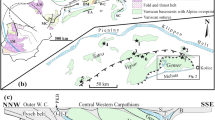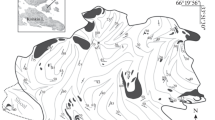Summary
Metabasites of the southern Ötztal basement hitherto mapped as amphibolites, were identified as eclogites. Primary mineral parageneses are tschermakitic to pargasitic green amphiboles, omphacite (Jd40), garnet II (Gr20–30) Py10), phengite (Si3.5), zoisite, rutile and quartz. Al—pargasite (≈20 wt% Al2O3) rims between garnet and omphacite are interpreted as retrograde reaction products.
Retrogression of the eclogite parageneses reflecting decreasing pressure and increasing temperature conditions are: Symplectites of diopside and plagioclase after omphacite, Al-and Na-poor green amphiboles, grossularite-poor garnet III surrounding garnet II partly with atoll textures and symplectites of biotite and plagioclase replacing phengite. Continuation of retrogression with decreasing temperature conditions is indicated by actinolitic amphiboles and albite-rims between amphibole II and quartz.
A pre-eclogitic metamorphic stage is only recorded by garnet I cores of discontinuous grossular-poor composition. Minimum pressure and temperature conditions of the eclogite stage derived from Jd-content in omphacite and the gt-cpx-geothermometer were 11–12 kbar and 500–550 °C. Maximum temperature conditions of the posteclogitic stage were between 600 and 650°C. Occurrence of these eclogitic metabasites as lenticular interlayers with ortho- and paragneisses indicate high pressure metamorphic conditions within the whole rock-sequence. This interpretation is confirmed by the occurrence of phengite-rich micas in orthogneisses indicating pressures of ≈ 11 kbar. S econdary chemical changes of these phengites to muscovite-rich compositions again show the decreasing pressure conditions in the southern Ötztal basement after the eclogite stage. The age of the eclogite stage is interpreted as Eoalpine due to the following arguments:
-
1.
The eclogites show concordant, tectonically undisturbed contacts to the encasing orthogneiss-metapelite series. This points to a common history during the last metamorphic evolutionary stage.
-
2.
Continuous readjustment from high to intermediate pressure conditions is observed in both, eclogites and acid country rocks.
-
3.
Isotopic results from the wider study area exclusively yield Cretaceous mineral ages. Rb-Sr data an eclogite phengites (texturally clearly correlated with the high-P stage) and thin whole rock slabs of layered eclogites are in agreement with a dominant post-Hercynian crystallization history, following a continuous high-P/low-T to low-P/high-T loop.
Zusammenfassung
Metabasite aus dem südlichen Ötztalkristallin, die als Amphibolite kartiert sind, wurden als Eklogite erkannt. Der primäre Mineralbestand setzt sich aus pargasitischem bis tschermakitischem, grünem Amphibol, Omphacit (Jd40), Granat II (Gr20–30 Py10), Phengit (Si3.5), Zoisit, Rutil und Quarz zusammen. Al-Pargasitränder (≈20 Gew.-% Al2O3) zwischen Granat und Omphacit werden als erste retrograde Reaktionsprodukte interpretiert.
Auf retrograde Umwandlung der Eklogitparagenesen bei fallendem Druck und steigender Temperatur weisen folgende Bildungen hin: Symplektite aus Diopsid und Plagioklas nach Omphacit, Al- und Na-armer, grüner Amphibol, Grossular-armer Granat III um Granat II (teilweise als Atollgranat) und Symplektite aus Biotit und Plagioklas nach Phengit. Aktinolithischer Amphibol und Albitränder zwischen Amphibol 11 und Quarz geben weitere Hinweise für andauernde retrograde Umwandlung bei der Druckentlastung.
Ein prä-eklogitisches Metamorphosestadium ist nur durch Granat 1-Kerne mit Grossular-armer Zusammensetzung belegt. Die minimalen PT-Bedingungen für das Eklogitstadium wurden aus dem Jd-Gehalt in Omphacit und dem Granat-Clinopyroxen-Geothermometer abgeleitet; sie liegen bei 11–12 kbar und 500–550 °C. Die maximalen Temperaturen für das posteklogitische Stadium betragen 600–650 °C. Das ungestörte Auftreten dieser eklogitisierten Metabasite als Linsen und Lagen in einer Ortho- und Paragneisabfolge weist darauf hin, daß die gesamte Serie eine Hochdruckentwicklung mitgemacht hat. Diese Interpretation wird durch Phengit-reiche Hellglimmer aus benachbarten Orthogneisen mit Druckwerten um 11 kbar gestützt. Die sekundäre chemische Veränderung des Chemismus dieser Phengite zu Muskowit-reicheren Zusammensetzungen weist auf abnehmende Druckverhältnisse nach dem Eklogitstadium im südlichen Ötztalkristallin hin. Das Alter der Eklogitmetamorphose wird auf Grund folgender Argumente als frühalpidisch vermutet.
-
1.
Die Eklogite weisen konkordante, tektonisch ungestörte Kontakte zu den Orthogneis-Metapelit-Hüllgesteinen auf. Das belegt eine gemeinsame Geschichte für das letzte metamorphe Entwicklungsstadium.
-
2.
Sowohl in den Eklogiten als auch in den sauren Hüllgesteinen ist eine kontinuierliche Anpassung von Hochdruck- zu intermediären Druck-Verhältnissen zu beobachten.
-
3.
Isotopenanalysen aus dem weiteren Untersuchungsgebiet ergaben ausschließich kretazische Mineralalter. Rb-Sr-Daten an Eklogit-Phengiten (die texturell eindeutig dem Hochdruckstadium angehören) sowie Rb-Sr-Ergebnisse an Eklogiten mit Feinlagenbau belegen im wesentlichen eine postvariscische Kristallisationsgeschichte. Für die frühalpidische Entwicklung kann somit ein kontinuierlicher PT-Pfad von “Hoch-P/Niedrig-T-” zu “Niedrig-P/Hoch-T-Bedingungen” konstruiert werden.
Similar content being viewed by others
References
Bence AE, Albee AL (1968) Empirical correction factors for the electron microanalysis of silicates and oxides. J Geol 76: 382–403
Coleman RG, Lee DE, Beatty LB, Brannock WW (1965) Eclogites and eclogites: Their differences and similarities. Geol Soc Am Bull 76: 483–508
Ellis DJ, Green DH (1979) An experimental study of the effect of Ca upon garnet-clinopyroxene Fe-Mg exchange equilibria. Contrib Mineral Petrol 71: 13–22
Ferry JM, Spear FS (1978) Experimental calibration of the partitioning of Fe and Mg between biotite and garnet. Contrib Mineral Petrol 66: 113–117
Frank W Hoinkes G, Purtscheller F, Thöni M (1987) The Austroalpine unit west of the Hohe Tauern: The Ötztal-Stubai complex as an example for the Eoalpine metamorphic evolution. In:Flügel HW Faupl P (eds) Geodynamics of the Eastern Alps, pp 179–202
Ghent ED (1976) Plagioclase-garnet-Al2SiO5-quartz: a potential geobarometer-geothermometer. Am Min 61: 710–714
van Gool JAM, Kemme MMJ, Schreurs GMMF (1987) Structural investigations along an E-W cross-section in the southern Ötztal Alps. In:Flügel HW Faupl P (eds) Geodynamics of the Eastern Alps, pp 214–225
Haüy RJ (1822) Traité de mineralogie, 2nd ed., 2, 594 pp., Bachelier, Paris
Hoinkes G (1986) Effect of grossular-content in garnet on the partitioning of Fe and Mg between garnet and biotite. Contrib Mineral Petrol 92: 393–399
Hoinkes G, Thöni M (1987) New findings of eclogites within the eoalpine amphibolite grade area of the ötztal basement. Terra cogn 7: 96
Hoinkes G, Frank W Mauracher J, Peschel R, Purtscheller F, Tessadri R (1987) Petrography of the Schneeberg Complex. In:Flügel HW, Faupl P (eds) Geodynamics of the Eastern Alps, pp 190–199
Krogh EJ (1988) The garnet-clinopyroxene Fe-Mg geothermometer—a reinterpretation of existing experimental data. Contrib Mineral Petrol 99: 44–48
Laird J, Albee AL (1981) Pressure, temperature and time indicators in mafic schists: their application to reconstructing the polymetamorphic history in Vermont. Am J Sci 281: 127–175
Leake BE (1978) Nomenclature of amphiboles. Am Min 63: 1023–1052
Massonne HJ, Schreyer W (1987) Phengite geobarometry based on the limiting assemblage with K-feldspar, phlogopite, and quartz. Contrib Mineral Petrol 96: 212–224
Poli S (1989a) Pre-Hercynian magmatism in the Eastern Alps: the origin of metabasites from the Austroalpine basement. Schweiz Mineral Petrogr Mitt 69: 407–421
— (1989b) A reaction space for amphibole eclogite and garnet amphibolite. Terra abstr 1: TIEC 19
Powell R, Holland TJB (1988) An internally consistent dataset with uncertainties and correlations: 3. applications to geobarometry, worked examples and a computer program. J Metamorph Geol 6: 173–204
—, — (1990) Calculated mineral equilibria in the pelite system. KFMASH (K2O-FeO-MgO-Al2O3 -SiO2-H2O). Am Mineral 75: 367–380
Steiger RH, Jäger E (1977) Subcommission on geochronology: convention on the use of decay constants in geo- and cosmochronology. Earth Plan Sci Lett 36: 359–362
Thöni M with contributions byHoinkes G (1983) The thermal climax of the early Alpine metamorphism in the Austroalpine thrust scheet. Mem Sci Geol 36: 211–238
— (1986) The Rb-Sr thin slab isochron method—an unreliable geochronologic method for dating geologic events in polymetamorphic terrains? Mem Sci Geol 38: 283–352
—Hoinkes G (1987) Geochronological and Petrological Consequences of Eoalpine Metamorphic Overprinting. In: Flügel HW Faupl P (eds) Geodynamics of the Eastern Alps, pp 200–213
— (1988) Rb-Sr isotopic resetting in mylonites and pseudotachylites: implications for the detachment and thrusting of the Austroalpine basement nappes in the Eastern Alps. Jb Geol B-A 131/1: 169–201
Author information
Authors and Affiliations
Additional information
With 9 Figures
Rights and permissions
About this article
Cite this article
Hoinkes, G., Kostner, A. & Thöni, M. Petrologic constraints for eoalpine eclogite facies metamorphism in the austroalpine Ötztal basement. Mineralogy and Petrology 43, 237–254 (1991). https://doi.org/10.1007/BF01164529
Received:
Accepted:
Issue Date:
DOI: https://doi.org/10.1007/BF01164529




